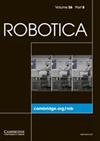共同设计多功能四足机器人,实现动态节能运动
IF 2.7
4区 计算机科学
Q3 ROBOTICS
引用次数: 0
摘要
本文介绍了一种针对四足动物设计和运动的并行优化方法,以实现高能效的循环行为。计算技术被用于改进新型四足机器人原型的开发。考虑到包括摩擦、扭矩和带宽限制在内的完整执行器模型,对机器人及其执行器的规模进行了能效优化。这种方法和最优边界轨迹在原型设计的第一次(非优化)迭代中进行了测试,结果表明,我们的方法所产生的轨迹 (i) 可以在真实机器人上轻松重放,(ii) 比人工调整的运动启发式方法降低了功耗。然后,通过协同设计对若干周期性任务的功耗进行优化。我们的结果包括(但不限于)束缚和后空翻任务。在向前跳跃时,大腿较长的机器人似乎表现更好,而在后空翻时,小腿较长的机器人更适合。为了探索这些不同设计之间的权衡,我们构建了一个帕累托集合来指导原型的下一次迭代。在这个集合上,我们找到了一种新的设计,并将在今后的工作中加以应用,它在每项单独任务中都显示出至少 52% 的改进。本文章由计算机程序翻译,如有差异,请以英文原文为准。
Co-designing versatile quadruped robots for dynamic and energy-efficient motions
This paper presents a concurrent optimization approach for the design and motion of a quadruped in order to achieve energy-efficient cyclic behaviors. Computational techniques are applied to improve the development of a novel quadruped prototype. The scale of the robot and its actuators are optimized for energy efficiency considering the complete actuator model including friction, torque, and bandwidth limitations. This method and the optimal bounding trajectories are tested on the first (non-optimized) prototype design iteration showing that our formulation produces a trajectory that (i) can be easily replayed on the real robot and (ii) reduces the power consumption w.r.t. hand-tuned motion heuristics. Power consumption is then optimized for several periodic tasks with co-design. Our results include, but are not limited to, a bounding and backflip task. It appears that, for jumping forward, robots with longer thighs perform better, while, for backflips, longer shanks are better suited. To explore the tradeoff between these different designs, a Pareto set is constructed to guide the next iteration of the prototype. On this set, we find a new design, which will be produced in future work, showing an improvement of at least 52% for each separate task.
求助全文
通过发布文献求助,成功后即可免费获取论文全文。
去求助
来源期刊

Robotica
工程技术-机器人学
CiteScore
4.50
自引率
22.20%
发文量
181
审稿时长
9.9 months
期刊介绍:
Robotica is a forum for the multidisciplinary subject of robotics and encourages developments, applications and research in this important field of automation and robotics with regard to industry, health, education and economic and social aspects of relevance. Coverage includes activities in hostile environments, applications in the service and manufacturing industries, biological robotics, dynamics and kinematics involved in robot design and uses, on-line robots, robot task planning, rehabilitation robotics, sensory perception, software in the widest sense, particularly in respect of programming languages and links with CAD/CAM systems, telerobotics and various other areas. In addition, interest is focused on various Artificial Intelligence topics of theoretical and practical interest.
 求助内容:
求助内容: 应助结果提醒方式:
应助结果提醒方式:


